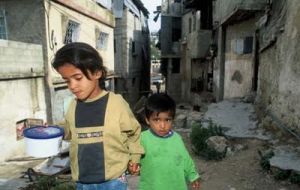MercoPress. South Atlantic News Agency
Chile with the worst OECD indexes; income ratio between rich and poor 27 to 1
 Shanty towns in Santiago metropolis are very common
Shanty towns in Santiago metropolis are very common According to a new study by the Organization for Economic Co-operation and Development, income inequality in most economically developed countries is the worst it has been in nearly 25 years. Ten countries from the OECD report, particularly Chile are identified as having the worst income inequality.
“In OECD countries today the average income of the richest ten percent of the population is about nine times that of the poorest 10%” the study reports. And in many of these countries, income inequality is increasing as more and more wealth is concentrated in the hands of the rich.
In some countries the gap is even more pronounced. The income of the bottom 10% of earners has actually declined while the income of the top 10% has increased. In Israel, Turkey and the United States, the average income of the top 10% is 14 to one compared to the bottom 10%. In Mexico and Chile, it is an astounding 27-to-one.
In many of the countries with the greatest levels of income inequality, there is also very limited public social expenditure. Seven of the 10 countries on this list spend below the OECD average — as a percentage of GDP — on social benefits. For example, the share of unemployed who receive benefits in both Chile and Turkey are less than half the OECD average. Mexico has no unemployment insurance at all.
The ten countries on the list are ranked by their levels of income inequality using the Gini coefficient, where zero represents perfectly equal distribution and one represents maximum inequality. Also included are the change in income inequality from the mid-1980s, employment rates and the change in income for the rich and poor. While inequality has worsened in most countries, the situation has improved in some. Even in these countries, however, inequality remains at historically high levels.
The Chilean charter shows a Gini coefficient: 0.494; Change in income inequality: n/a; Employment rate: 59.3% (4th lowest); Change in income of the rich: +1.2% per year and Change in income of the poor: +2.4% per year
Chile is one of the few countries where the income of the poor increased at a higher annual rate than the income of the wealthy, 2.4% to 1.2%. Nevertheless, Chile has the worst income inequality among the 27 OECD nations examined. Chile has a particularly high rate of self-employed individuals, primarily because of its large farming class. The income ratio of the top 10% to the bottom 10% is 27-to-one.




Top Comments
Disclaimer & comment rules-

-

-

Read all commentsCan this happen to a normal Chile? no no no
Dec 12th, 2011 - 06:30 am 0better being worst, second worst or lower range of the best 30,
Dec 12th, 2011 - 02:14 pm 0than best of the 30 worst...
keep tryin, xbarilox ;)
PS: By the way, income inequality in Argentina, against rumors over there, isn't much better. Not much people with really high incomes in Argentina make the difference and bends the statistic.
It so happens that income inequality in Argentina is actually falling, and the same is happening is most of South America. Chile is an exception to that trend. Chileans will sooner or later regret their mindless cheering of right-wing policies as they lead your country to bitter social tensions.
Dec 12th, 2011 - 02:29 pm 0Commenting for this story is now closed.
If you have a Facebook account, become a fan and comment on our Facebook Page!